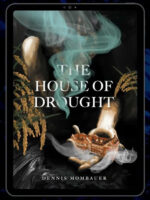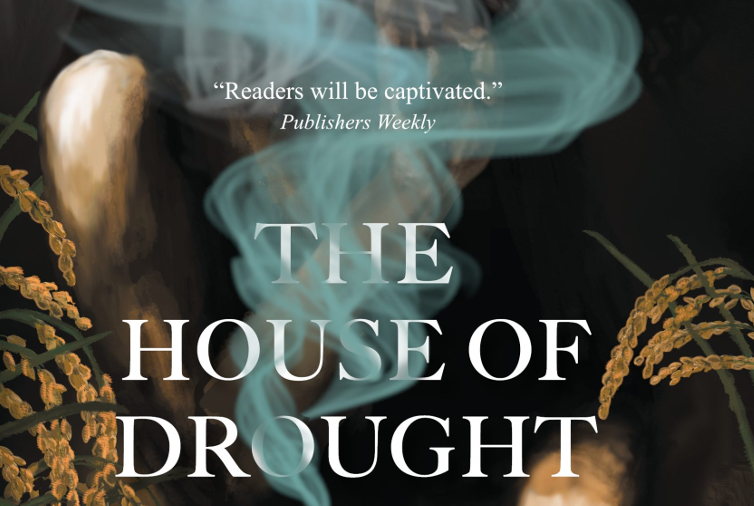 The House of Drought
The House of Drought
By Dennis Mombauer
Stelliform Press, Jul. 2022, 106 pp., ebook: $5.00, paperback: $14.00.
I found Dennis Mombauer’s supernatural eco-novella The House of Drought to be both captivating and confusing. I reveled in its vivid prose and exquisitely rendered weird horror tone, but had trouble following its story due to the dreamlike arbitrariness governing much of it. Perhaps the best way to enjoy this book is to simply roll with its dreamlike logic and try to feel it rather than understand it.
When at its best, the novella is an effective exercise in atmosphere and tension that plays on our fears of the dark, of being lost, of being watched and of strange noises in the night. Its setting is an eerie, abandoned colonial mansion possessed by a vengeful forest spirit. Much of the time nothing seems amiss about this mansion, aside from its unnaturally parched air. At other times it’s like a nightmare dreamscape with impossible Lovecraftian geometries, dramatic time dilations and all manner of other strange phenomena.
Located between forest and farmland near the Sri Lankan village of Anathakandu, the mansion was constructed in the late 19th century by an English plantation owner. He built it despite warnings that the land could not support the water demands of both a mansion and the nearby rice paddy fields. True to the warnings, the mansion began sucking the land dry, causing the fields to wither and the forest to retreat. The spirit inhabiting the land never forgot the insult.
Local villagers know this spirit by various names, including the Sap Mother, the White Lady and Anik Amma. She appears at night in the form of a white, luminous figure with oily seeds for eyes and sap for blood and breastmilk. It’s said that she nurtures those who live in the forest, and that she lures children and lone male travelers into the woods, where she feeds off their energy and they in turn sate her need to give succor to others. The villagers collect and consume her milk, which they say wards off illness. In return they leave her cans of seeds to help her grow. The Sap Mother also visits her ghostly presence upon the mansion whenever someone makes the unfortunate decision to venture into it.
The book tells the stories of numerous people who have made this decision over the years. Most of these people have disappeared forever, but there is one case in which several children reemerged from the house decades after they vanished into it. Like characters in a science fiction plot involving the time-distorting properties of black holes or faster-than-light space travel, they failed to age noticeably in the years they were gone, and upon their return they believed they had been gone for only a few weeks. They claimed to have been trapped in the house’s “other side”—also known as the “Dry House”—an alternate dimension that seems to appear when the house’s air runs out of moisture.
The novella also tells of those who have managed to avoid being trapped in the mansion but have fallen victim to a different, yet equally bizarre, form of imprisonment within the Sap Mother’s forest realm.
The plot jumps around in time as it interweaves these various stories, which include those of a down-on-his-luck farmer who seeks refuge in the mansion for himself and his family as they flee thugs intent on collecting a debt, a prominent Sri Lankan legal scholar and his family, and a German filmmaker shooting a documentary on the impacts of climate change on local farming villages, among others. In all, there are several timelines and groups of characters spanning as many decades.
There are issues with how all of this is executed. Not all the characters are equally well developed, but how could they be in a book of just 106 pages? The rules behind the story’s paranormal happenings can seem random or even contradictory; sometimes things just seem to happen—again, like in a dream. There’s some awesomely surreal imagery in which the inside of the house seems to morph into a series of M.C. Escher paintings in order to thwart the characters’ attempts to escape it, but there’s a lot of other stuff that feels like pointless surrealism, including some truly puzzling business involving mirrors and a photograph. The Dry House and the Sap Mother often feel disconnected from each other; it isn’t clear how their respective supernatural phenomena interrelate.
Ironically, it’s often when the book is the very opposite of surreal that it’s most successful. Apart from its supernatural elements, it serves as a portrait of the real-life effects of climate change on the wildlife and people of Sri Lanka. A case in point is the farmer who takes himself and his family into hiding from his debt collectors. He represents the plight of real-life Sri Lankan farmers who face debt, food insecurity and malnutrition when harvests fail due to climate change-fueled drought. The book also poignantly depicts desiccated fields, villages depopulated due to migration to better climes and elephants attacking villages in search of water. All of this is very much based in reality.
The House of Drought certainly doesn’t want for ambition. It’s crammed with ideas, tries to juggle multiple casts of characters across disparate timelines, and pulls from the gamut of supernatural fantasy themes, from haunted dwellings to folklore to possession to alternate dimensions. If only the execution more consistently matched the ambition.






